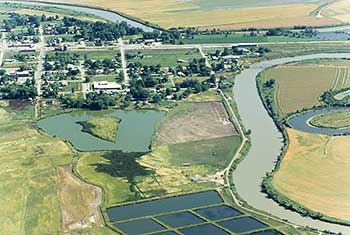| 24-25 | 26 | Aug 27 - Sep 4 | 5 | 6 | 7-8 | 9 | 10 | 11 | 12 | 13 | 14 | 15 | All Photos |
August 19-20, 1841
Turn right onto 6400 North, and travel west, crossing the Malad River and then a railroad track, to the JUNCTION (2.6 miles) with 6800 West. Turn left onto 6800 West, and travel south to the JUNCTION (4.0 miles) with SR 83. The area to the south and to the east is where the Bidwell-Bartleson party traveled some twelve to thirteen miles in a triangular route looking for Great Salt Lake and fresh water for themselves and their livestock. John Bidwell described this search:
"Started early, hoping soon to find fresh water, when we could refresh ourselves and animals, but alas! The sun beamed heavy on our heads as the day advanced, and we could see nothing before us but extensive arid plains, glimmering with heat and salt, at length the plains became so impregnated with salt, that vegetation entirely ceased; the ground was in many places white as snow with salt & perfectly smooth--the mid-day sun, beaming with uncommon splendor upon these shining plains, made us fancy we could see timber up on the plains, and wherever timber is found there is water always. We marched forward with unremitted pace till we discovered it was an illusion, and lest our teams should give out we returned from S. to E. and hastened to the river which we reached in about 5 miles. A high mountain overlooked us on the East and the river was thickly bordered with willows--grass plenty but so salt, our animals could scarcely eat it; salt glitters upon its blades like frost. Distance 20 miles."
Continue south on 6800 West to the JUNCTION (1.0 miles) with an unmarked east-west road. Turn left onto this road and travel east to CORINNE, 3.5 miles, location of the 19-20 AUGUST CAMPSITE. The party remained here for two days while they explored the surrounding country. They were ten miles from Great Salt Lake.
The first Gentile (the Mormon term for a non-Mormon) town in Utah, Corinne strived to become a commercial center following completion in 1869 of the transcontinental railroad at nearby Promontory; a steamboat center following construction of the City of Corinne and the Kate Connor, two unsuccessful steamboats that operated on Great Salt Lake in the early 1870s hauling machinery and ore for the mines south of Great Salt Lake; and a political center following establishment of the first political party to oppose the Mormon People's Party. But events kept the town from fulfilling its promise. A diphtheria epidemic in 1872 devastated the population, and completion in 1903 of the Lucin cutoff trestle across the middle of Great Salt Lake finished the economy. Even Corinne's old enemies admit that the town did much to establish the commercial status of Utah. Failure dogged all of its ambitions., but it was the first gentile town in Utah, had the first gentile school, was the home of the first political party to oppose the Mormon peoples Party, and was the first to put steamboats on Great Salt Lake. It is now just a sleepy little farming community.
August 18, 1841  |
 August 21-22, 1841 August 21-22, 1841 |
|---|
